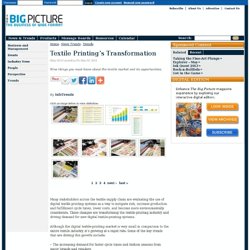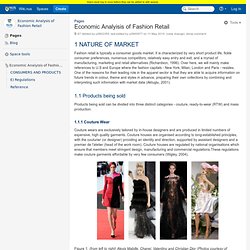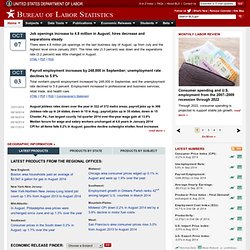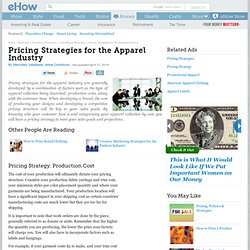

The Big Picture - Wide Format Printing. (May 2013) posted on Fri May 03, 2013 Nine things you must know about the textile market and its opportunities.

By InfoTrends click an image below to view slideshow Many stakeholders across the textile supply chain are evaluating the use of digital textile printing systems as a way to mitigate risk, increase production and fulfillment cycle times, lower costs, and become more environmentally considerate. These changes are transforming the textile-printing industry and driving demand for new digital textile-printing systems. Although the digital textile-printing market is very small in comparison to the entire textile industry, it’s growing at a rapid rate. . • The increasing demand for faster cycle times and fashion seasons from major brands and retailers; • A growing demand for textile-based products that meet regulatory and corporate preferences for environmental properties;
Clothing, Garment, Apparel Industry Overview. The textile industry touches the lives of all people in one or the other ways.

Apparel, Home textiles, Technical textiles, Industrial textiles, Medical textiles, Safety textiles, Smart or Intelligent textiles, there are variations for all - Consumers, Traders, Manufacturers, Technologists, Engineers and others. History of Textile Industry- A Reference Textile industry has come a long way to be an organized industry from being a mere domestic industry.
Starting with the Industrial Revolution, it has gained a state of supremacy with time. High production of wool, cotton and silk all over the world has given a boost to the textile industry in past years. The World Trade Organization (WTO) has taken important steps for development of this sector. Global Textile Scenario - The Present Statistics According to statistics, the global textile market is worth of more than $400 billions at present. It is expected that China will represent around 45% of global trade by 2010. You Are Everywhere: Mapping the New Retail Supply Chain. By Amy Roach Partridge Tags: 3PL, Inventory Management, Retail, E-commerce Gone are the days of single-channel apparel retailing—and supply chains servicing that model. Today, apparel retailers must optimize their supply chains to deliver products from any point where consumers want to buy them. The formula for apparel retail success used to be straightforward: give consumers quality, on-trend garments at the right price point, in an attractive store setting with helpful sales associates, and watch the dollars roll in.
Behind the scenes, the supply chain needed only to support the single mission of getting goods to retail stores on time—a largely predictable process. Today, however, the apparel retail environment is vastly different. Consider even the emerging channel of "broadcast retail," pioneered by the reality TV show Fashion Star. Economic Analyisis of Fashion Retail - Economic Analysis of Fashion Retail - Wiki.nus.
Fashion retail is typically a consumer goods market.

It is characterized by very short product life, fickle consumer preferences, numerous competitors, relatively easy entry and exit, and a myriad of manufacturing, marketing and retail alternatives (Richardson, 1996). Over here, we will mainly make references to U.S and Europe where the fashion capitals - New York, Milan, London and Paris - resides. One of the reasons for their leading role in the apparel sector is that they are able to acquire information on future trends in colour, theme and styles in advance, preparing their own collections by combining and interpreting such information with market data (Aktuglu, 2001). 1.1 Products being sold. Document details. Document details. Fashion: BLS Spotlight on Statistics. Job openings increase to 4.8 million in August; hires decrease and separations steady There were 4.8 million job openings on the last business day of August, up from July and the highest level since January 2001.

The hires rate (3.3 percent) was down and the separations rate (3.2 percent) was little changed in August. Www.unido.org/fileadmin/media/documents/pdf/Services_Modules/Apparel_Value_Chain.pdf. What Does It Really Cost To Make Those Clothes? Quote: your impression is correct, welcome to FS marrimoda since shops take a 200% profit, the 80$ t-shirt is sold at a mere 22$ by the manufacturer, regardless if this is a huge company or an indie designer.

Wholesale profits vary much if you are in mass marketing (you achieve much lower manufacturing/scourcing prices) than when you are 'small' start up business. At 22$ wholesale price, a young designer will not profit more than 6$ per real hight quality t-shirt most of which 6$ will go to covering packaging etc expences. Hence a 80$ t-shirt is sold cheap and is not really worth the time of the indie designer. Regarding 'what does it really cost' one should actually count: *cost of fabric & garment accessories *cost of manufaturing sample line *cost of manufacturing orders *cost of running the business *tax, logistics, etc *cost of communicating the product *cost of advertising *shipping its not as easy as it sounds.. much more if you happen to be a 'small or start up business'
Pricing Strategies for the Apparel Industry. The cost of your production will ultimately dictate your pricing structure.

Consider your production fabric yardage and trim cost, your minimum styles per color placement quantity and where your garments are being manufactured. Your production location will have a significant impact in your shipping cost as certain countries' manufacturing costs are much lower but they are too far for shipping. It is important to note that work orders are done by the piece, generally referred to as dozens or units. Remember that the higher the quantity you are producing, the lower the price your factory will charge you. You will also have to incorporate factors such as labels and hangtags.
ALeanSupplyChainis. Fashion_Review_April_2007.